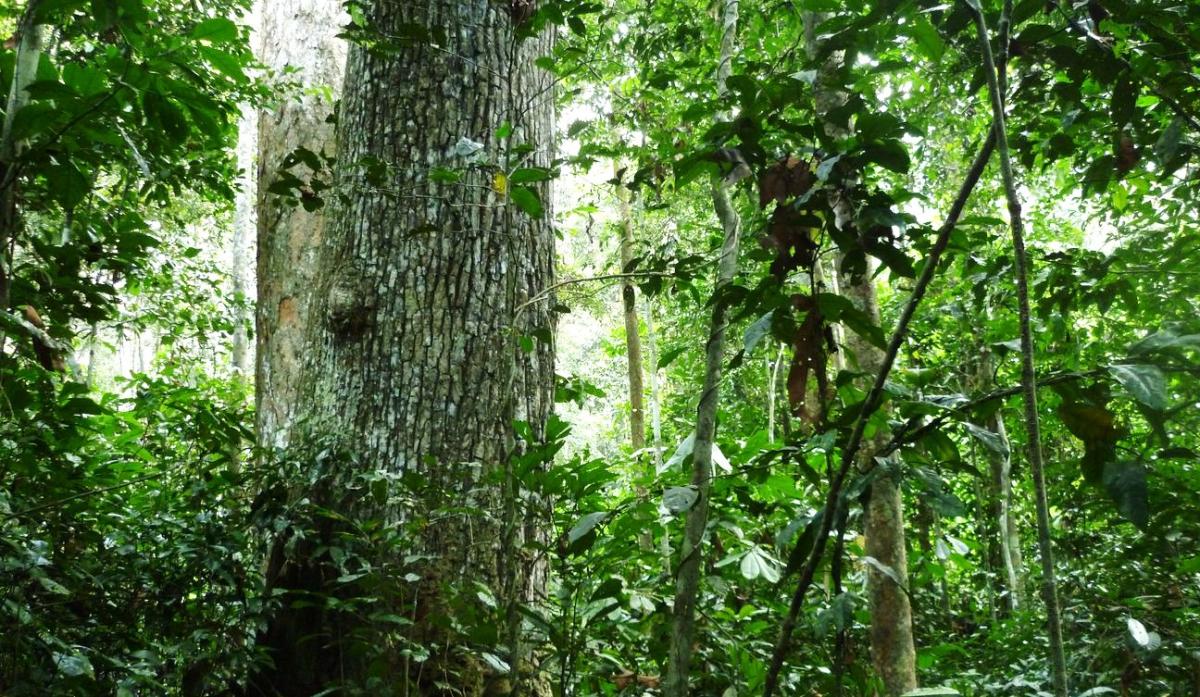Results & impact 10 October 2025
- Home
- Press area
- Press releases
- carbon storage decline tropical forests
In the tropics, intact forests are losing their ability to absorb carbon

The remaining intact African forests are storing less and less carbon, like this one in the Republic of the Congo © S. Gourlet-Fleury, CIRAD
The study, conducted by around 100 institutes from all over the world, tracked changes in “intact” tropical forests in the Amazon and Africa over 30 years. It is based on permanent monitoring plots, including those in the M’Baïki site in the Central African Republic, studied since 1982 by CIRAD and its Central African partners. This research has produced some sobering results. Whereas current climate models predict peak carbon uptake in the next few decades, the researchers involved have shown that, for tropical forests, this peak clearly occurred 20 to 30 years ago in the Amazon and, to a lesser extent, 10 to 20 years ago in Africa.
Carbon uptake is declining
In the 1990s, the world’s intact tropical forests sequestered around 12.6 billion tonnes of carbon dioxide over the decade. In the 2010s, this capacity fell to 6.8 billion tonnes. This capacity loss of 5.8 billion tonnes of carbon corresponds to a decade of fossil fuel emissions from the United Kingdom, Germany, France and Canada combined. Tropical forests removed 17% of anthropogenic carbon dioxide emissions in the 1990s, but this fell to only 6% of these emissions in the 2010s. These forests are absorbing less carbon, and their surface area is shrinking, while emissions are increasing dramatically.
Tropical forests could switch from a carbon sink to a carbon source
Simulations conducted for the next 20 years predict that in the Amazon, carbon losses from tree mortality will be equal to the carbon gained from their growth and to the recruitment of new trees before 2040. This means that forests will no longer be sinks, and could instead become sources of carbon emissions. In Africa, this shift is much slower, and the forests there should remain sinks for a longer period, but will absorb less and less carbon.
The authors of the study insist on the urgency of the situation, reiterating in their publication that international agreements to reduce greenhouse gas emissions need to be reviewed. Based on overly optimistic climate models, “given that tropical forests are likely to sequester less carbon in the future than [predicted] ”, they will not be sufficient to meet commitments on global warming.
Sustainable forestry to capture carbon
However, this study focuses on the past and future evolution of intact forests, which account for only 25% of all forest cover. Other forests are managed alongside them, in which trees are harvested, in particular to provide timber.
“Well-managed forests, in other words respecting well-designed development plans and not opening new areas to logging, store carbon. The timber harvested sequesters carbon, and this timber can be used instead of other materials whose production is much more polluting ”, says Sylvie Gourlet-Fleury, a researcher in forest ecology at CIRAD and co-author of the publication. “Thus, the decrease in the number of large trees that stored this timber, which are logged, stimulates the growth of those that remain and reduces natural mortality. Sustainably managing parts of tropical forests may sometimes be more judicious than putting them all under protection ”.
In many places, the drivers of forest degradation and deforestation will be amplified by demand from local populations and countries’ development needs. These alarming predictions have led to the launch of regional initiatives, such as Initiative 20x20 in Latin America and the Caribbean, or AFR100 in Africa (the African Forest Restoration Initiative), aimed at rapidly restoring 150 million hectares of the world’s degraded and deforested lands. These initiatives converge with those launched by the Bonn Challenge in 2011 and the New York Declaration on Forests during the United Nations Climate Summit in 2014, which ups the restoration target to 350 million hectares by 2030.
“Restoring degraded forests or planting trees is an effective way to store carbon. Including timber plantations in these operations, over and above fast-growing species aimed at providing fuelwood, is one of CIRAD’s priorities for the coming years ”, says Sylvie Gourlet-Fleury. “These are necessary actions, which go hand in hand with the revision of international agreements to reduce greenhouse gas emissions. One cannot go without the othe r”.
Reference
Hubau, W., Lewis, S.L., Phillips, O.L. et al. Asynchronous carbon sink saturation in African and Amazonian tropical forests. Nature 579, 80–87 (2020).
Other references
Gourlet-Fleury, S., Mortier, F., Fayolle, A., Baya, F., Ouédraogo, D., Bénédet, F., Picard, N. (2013). Tropical forest recovery from logging: a 24 year silvicultural experiment from Central Africa. Philosophical Transactions of the Royal Society B, 368: 20120302



























